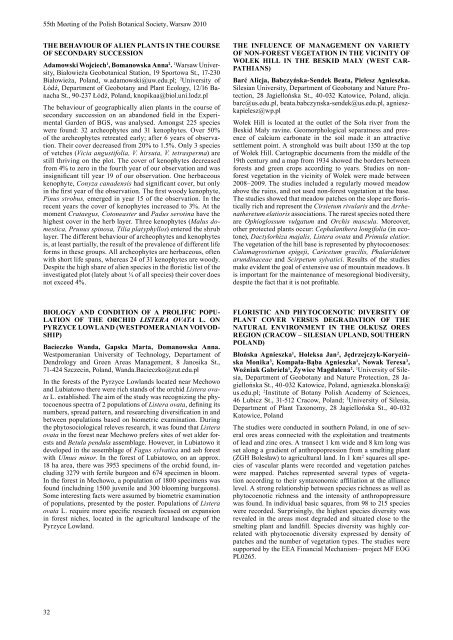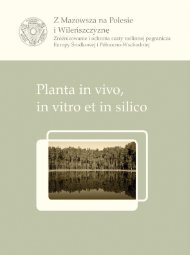acta societatis botanicorum poloniae - LV Zjazd Polskiego ...
acta societatis botanicorum poloniae - LV Zjazd Polskiego ...
acta societatis botanicorum poloniae - LV Zjazd Polskiego ...
You also want an ePaper? Increase the reach of your titles
YUMPU automatically turns print PDFs into web optimized ePapers that Google loves.
55th Meeting of the Polish Botanical Society, Warsaw 2010<br />
THE BEHAVIOUr OF ALIEN PLANTS IN THE COUrSE<br />
OF SECONdArY SUCCESSION<br />
Adamowski Wojciech1 , Bomanowska Anna2 . 1Warsaw University,<br />
Białowieża Geobotanical Station, 19 Sportowa St., 17-230<br />
Białowieża, Poland, w.adamowski@uw.edu.pl; 2University of<br />
Łódź, Department of Geobotany and Plant Ecology, 12/16 Banacha<br />
St., 90-237 Łódź, Poland, knopikaa@biol.uni.lodz.pl<br />
The behaviour of geographically alien plants in the course of<br />
secondary succession on an abandoned field in the Experimental<br />
Garden of BGS, was analysed. Amongst 225 species<br />
were found: 32 archeophytes and 31 kenophytes. Over 50%<br />
of the archeophytes retreated early; after 6 years of observation.<br />
Their cover decreased from 20% to 1.5%. Only 3 species<br />
of vetches (Vicia angustifolia, V. hirsuta, V. tetrasperma) are<br />
still thriving on the plot. The cover of kenophytes decreased<br />
from 4% to zero in the fourth year of our observation and was<br />
insignificant till year 19 of our observation. One herbaceous<br />
kenophyte, Conyza canadensis had significant cover, but only<br />
in the first year of the observation. The first woody kenophyte,<br />
Pinus strobus, emerged in year 15 of the observation. In the<br />
recent years the cover of kenophytes increased to 3%. At the<br />
moment Crataegus, Cotoneaster and Padus serotina have the<br />
highest cover in the herb layer. Three kenophytes (Malus domestica,<br />
Prunus spinosa, Tilia platyphyllos) entered the shrub<br />
layer. The different behaviour of archeophytes and kenophytes<br />
is, at least partially, the result of the prevalence of different life<br />
forms in these groups. All archeophytes are herbaceous, often<br />
with short life spans, whereas 24 of 31 kenophytes are woody.<br />
Despite the high share of alien species in the floristic list of the<br />
investigated plot (lately about ¼ of all species) their cover does<br />
not exceed 4%.<br />
BIOLOGY ANd CONdITION OF A PrOLIFIC POPU-<br />
LATION OF THE OrCHId listerA ovAtA L. ON<br />
PYrZYCE LOWLANd (WESTPOMErANIAN VOIVOd-<br />
SHIP)<br />
Bacieczko Wanda, Gapska Marta, domanowska Anna.<br />
Westpomeranian University of Technology, Departament of<br />
Dendrology and Green Areas Management, 8 Janosika St.,<br />
71-424 Szczecin, Poland, Wanda.Bacieczko@zut.edu.pl<br />
In the forests of the Pyrzyce Lowlands located near Mechowo<br />
and Lubiatowo there were rich stands of the orchid Listera ovata<br />
L. established. The aim of the study was recognizing the phytocoenous<br />
spectra of 2 populations of Listera ovata, defining its<br />
numbers, spread pattern, and researching diversification in and<br />
between populations based on biometric examination. During<br />
the phytosociological releves research, it was found that Listera<br />
ovata in the forest near Mechowo prefers sites of wet alder forests<br />
and Betula pendula assemblage. However, in Lubiatowo it<br />
developed in the assemblage of Fagus sylvatica and ash forest<br />
with Ulmus minor. In the forest of Lubiatowo, on an approx.<br />
18 ha area, there was 3953 specimens of the orchid found, including<br />
3279 with fertile burgeon and 674 specimen in bloom.<br />
In the forest in Mechowo, a population of 1800 specimens was<br />
found (includning 1500 juvenile and 300 blooming burgeons).<br />
Some interesting facts were assumed by biometric examination<br />
of populations, presented by the poster. Populations of Listera<br />
ovata L. require more specific research focused on expansion<br />
in forest niches, located in the agricultural landscape of the<br />
Pyrzyce Lowland.<br />
32<br />
THE INFLUENCE OF MANAGEMENT ON VArIETY<br />
OF NON-FOrEST VEGETATION IN THE VICINITY OF<br />
WoŁEK HILL IN tHE BESKID MAŁy (WESt CAR-<br />
PATHIANS)<br />
Barć Alicja, Babczyńska-Sendek Beata, Pielesz Agnieszka.<br />
Silesian University, Department of Geobotany and Nature Protection,<br />
28 Jagiellońska St., 40-032 Katowice, Poland, alicja.<br />
barc@us.edu.pl, beata.babczynska-sendek@us.edu.pl, agnieszkapielesz@wp.pl<br />
Wołek Hill is located at the outlet of the Soła river from the<br />
Beskid Mały ravine. Geomorphological separatness and presence<br />
of calcium carbonate in the soil made it an attractive<br />
settlement point. A stronghold was built about 1350 at the top<br />
of Wołek Hill. Cartographic documents from the middle of the<br />
19th century and a map from 1934 showed the borders between<br />
forests and green crops according to years. Studies on nonforest<br />
vegetation in the vicinity of Wołek were made between<br />
2008– 2009. The studies included a regularly mowed meadow<br />
above the ruins, and not used non-forest vegetation at the base.<br />
The studies showed that meadow patches on the slope are floristically<br />
rich and represent the Cirsietum rivularis and the Arrhenatheretum<br />
elatioris associations. The rarest species noted there<br />
are Ophioglossum vulgatum and Orchis mascula. Moreover,<br />
other protected plants occur: Cephalanthera longifolia (in ecotone),<br />
Dactylorhiza majalis, Listera ovata and Primula elatior.<br />
The vegetation of the hill base is represented by phytocoenoses:<br />
Calamagrostietum epigeji, Caricetum gracilis, Phalaridetum<br />
arundinaceae and Scirpetum sylvatici. Results of the studies<br />
make evident the goal of extensive use of mountain meadows. It<br />
is important for the maintenance of mesoregional biodiversity,<br />
despite the fact that it is not profitable.<br />
FLOrISTIC ANd PHYTOCOENOTIC dIVErSITY OF<br />
PLANT COVEr VErSUS dEGrAdATION OF THE<br />
NATUrAL ENVIrONMENT IN THE OLKUSZ OrES<br />
rEGION (CrACOW – SILESIAN UPLANd, SOUTHErN<br />
POLANd)<br />
Błońska Agnieszka 1 , Holeksa Jan 2 , Jędrzejczyk-Korycińska<br />
Monika 3 , Kompała-Bąba Agnieszka 1 , Nowak Teresa 3 ,<br />
Woźniak Gabriela 1 , żywiec Magdalena 2 . 1 University of Silesia,<br />
Department of Geobotany and Nature Protection, 28 Jagiellońska<br />
St., 40-032 Katowice, Poland, agnieszka.blonska@<br />
us.edu.pl; 2 Institute of Botany Polish Academy of Sciences,<br />
46 Lubicz St., 31-512 Cracow, Poland; 3 University of Silesia,<br />
Department of Plant Taxonomy, 28 Jagiellońska St., 40-032<br />
Katowice, Poland<br />
The studies were conducted in southern Poland, in one of several<br />
ores areas connected with the exploitation and treatments<br />
of lead and zinc ores. A transect 1 km wide and 8 km long was<br />
set along a gradient of anthropopression from a smelting plant<br />
(ZGH Bolesław) to agricultural land. In 1 km 2 squares all species<br />
of vascular plants were recorded and vegetation patches<br />
were mapped. Patches represented several types of vegetation<br />
according to their syntaxonomic affiliation at the alliance<br />
level. A strong relationship between species richness as well as<br />
phytocoenotic richness and the intensity of anthropopressure<br />
was found. In individual basic squares, from 98 to 215 species<br />
were recorded. Surprisingly, the highest species diversity was<br />
revealed in the areas most degraded and situated close to the<br />
smelting plant and landfill. Species diversity was highly correlated<br />
with phytocoenotic diversity expressed by density of<br />
patches and the number of vegetation types. The studies were<br />
supported by the EEA Financial Mechanism– project MF EOG<br />
PL0265.



